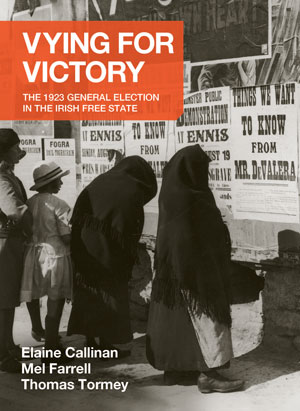ELAINE CALLINAN, MEL FARRELL and THOMAS TORMEY (eds)
University College Dublin Press
€25
ISBN 9781910820704
Reviewd by Brian Girvin

Brian Girvin is a Fellow of the Royal Historical Society.
Was the 1923 general election the most important in independent Ireland? The contributors to this book certainly believe that a strong case can be made for this claim. Its importance has long been recognised, and yet, as Mel Farrell points out in his introduction to this timely study, it has not received the attention that it warrants. The outcome would determine the future of the new state and what form its political system would take. Each contributor approaches the election from a different angle but taken together they provide a comprehensive narrative that sustains their claim. Because the book is focused on a single event in time and space there is a welcome coherence to this volume.
Chapters establish the international context for the Irish Free State, analyse the political and electoral strategies of Cumann na nGaedheal and Éamon de Valera, and explain the impact of smaller parties and independents. Other contributions focus on the role of the Catholic Church, the importance of political communication and the position taken by newspapers in Kerry. Another chapter provides a guide to the results, accompanied by detailed data on the constituencies. These are rounded off by a chapter on women in the election and one on the intervention of the American Association for the Recognition of the Irish Republic, which supported the anti-Treaty republicans.
Gearóid Barry reminds us of the precarious international environment within which the Irish Free State went to the polls in 1923. The March on Rome by Mussolini had taken place the previous year, while Weimar Germany faced economic and social collapse as a result of the occupation of the Ruhr and the hyperinflation that followed. In other parts of Europe coups and counter-coups undermined fledgling democratic systems. Barry draws a very positive picture for Ireland: ‘the speedy move in Ireland’s case from civil war to electoral competition as the normative arena of politics is remarkable if not completely unique in European context’. The outcome of this election reinforced the democratic foundations of the new state, establishing parliamentary democracy and majority rule as central to political competition. Ireland was the only state established after 1917 to fully consolidate and deepen its democracy by 1939 (Finland remained democratic but was not consolidated).
When the 1923 election was called, thousands of republicans were in jail or on the run, as was Éamon de Valera. According to David McCullough ‘He had lost power; he had lost status; he had lost influence’, but the election provided the opportunity for de Valera to become a major political figure once again. He did so by insisting that republicans would eschew violence in their confrontation with the Free State, while also seeking to attract nationalist voters from beyond the anti-Treaty core. His stance was vindicated by the outcome. Despite the unfavourable circumstances for republicans, they captured 27.6% of the vote, winning 44 seats. De Valera now set the republican movement on a path that led to Fianna Fáil’s entry to the Dáil, partial recognition of the Free State and ultimately electoral victory in 1932.
Cumann na nGaedheal attracted 39% of the vote and won 63 seats. Mel Farrell highlights the importance of a new party established to defend the Treaty settlement, secure public order and promote nationalist state-building. As a moderate conservative party, it attracted support from pro-Treaty Sinn Féin, former Home Rule supporters, unionists and the Catholic professional and middle classes. Farrell rejects the view that the Cumann na nGaedheal vote was disappointing, emphasising that no single party in a competitive political system was likely to achieve the type of vote previously associated with Sinn Féin or the Home Rule party.
This was the first multi-party competitive election, with 376 candidates vigorously campaigning across the country. Smaller parties had hoped to do well but did not achieve a major breakthrough, as Jason Knirck makes clear. They attracted a third of the vote, winning 46 seats. Notwithstanding this, the election cemented the nationalist basis of Irish political competition, pitting two nationalist parties against one another. This is unusual in a Western European context, where class and religion often determined voter loyalty, but is not significantly different from the experience of India and Israel in the decades after independence. This remained the case in Ireland until the 2011 general election.
Importantly, the election secured the Treaty settlement for the next decade. The electorate overwhelmingly supported candidates who endorsed the Free State, securing the legitimacy of the state and its institutions. Elaine Callinan suggests that not all sections of the Labour Party were pro-Treaty, but public statements by Labour candidates suggest otherwise, while two thirds of Labour transfers went to pro-Treaty candidates. The election also relegated women to the back seat of politics for the next 50 years, despite universal suffrage.
The year 1923 marked the end of a long period of violence, uncertainty and instability in Ireland and much of Europe. Normalisation was secured by Cumann na nGaedheal’s political success and by republican participation in the democratic process. This welcome book adds to a growing literature reassessing the first decade of the Irish Free State, highlighting its success as a newly independent state operating under difficult circumstances.
